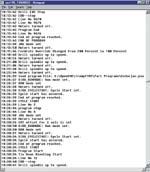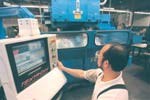What Does It Take To Internet-Enable Machine Tools?
It takes data—complete machine and process data from a machine tool that is easily linked to a factory network and easily exported.
Share





With fierce competitive pressure to improve efficiency, manufacturers require more detailed data from their machine tools, and they need it in real time. If you can't measure it, you can't manage it. The data need to be accessible and exchangeable, without expensive add-ons that take the profit out of the operation. Complete machine and process data from a machine tool that is easily linked to a factory network and easily exported are the key to Internet-enabled manufacturing.
The question is how do you get there?
Getting Data From A Machine Tool
There are four methods currently used in manufacturing to gather and analyze data:
1. Manual data gathering. Engineers conduct manual time studies using a clipboard and a stopwatch. This approach is expensive and neither precise nor timely.
2. Purchasing new machines equipped with application-specific sensors and data collection devices. This approach also has drawbacks. First, replacing old machines is expensive. Second, the new machines quite likely have limited data collection capabilities due to the limitations of the traditional, closed CNCs, which typically only have a data link via the PLC. Finally, if there are changes in what data needs to be collected because of changes in the manufacturing process, the data collection devices have to be changed, making it difficult and expensive to keep up.
3. Using bolt-on or third-party data collection devices. These devices are expensive, limited in how finely detailed the data they collect can be and inflexible because they are tied into the machine control via a PLC. Thus, the rate of data collection is defined by the scan rate of the PLC. This means that an engineer does not have the ability to drill down and mine the data required to answer the question of why something happened.
4. Using a software CNC system that collects production and machine data into a single data repository. This method offers the flexibility and integration of control functions with data collection. It integrates both CNC and PLC data.
It's Not Just What Happened, But Why
Why did cycle times increase during third shift? What caused the machine to fail? For complex manufacturing operations, it's not enough to know what happened. Managers need to know why, in real time, so they can modify processes in a timely manner.
Traditional machine control technology relies upon loosely coupled or integrated solutions. The two components of the machine control—motion and PLC (programmable logic control)—are typically supplied by separate companies or by separate operating units of large corporations. A similar situation existed in the CAD/CAM industry, where computer-aided design products come from one company while computer-aided manufacturing (NC programming) products come from separate companies.
The CAD product has a database of information on the design of a part. The CAM product has a database on the manufacturing processes to machine the part. The connection in many cases is via IGES or similar data translators. As a result, it is difficult, expensive, and time-consuming to build cause-and-effect relationships. However, CAD/CAM products, such as IDEAS, Pro/Engineer or Catia, solved that long-standing data problem 10 years ago, because they provided integrated solutions built upon a common database. The objective is to provide data of associative relationships between design and manufacturing.
In the same way, there is a need for cause-and-event relationships between the motion and PLC components in machine control. This is what is necessary to truly understand the manufacturing process and to continue to improve those processes. Ideally, a machine control should integrate motion and PLC functions in its software and share a common data repository. This enables the development of associative relationships between PLC functions, such as coolant on/off, and motion functions, such as high speed cutting. All of this information should be accessible from the operator interface or remotely, across a network.
A software-based CNC with a real-time database at its core meets these criteria. Collection and distribution of data from the machine tool in real time are an automatic result of running the machine. Collection and distribution of the data is an integral part of the CNC. Data is generated by the operator, the part program, the motion control, and the PLC, concurrently, and all data is collected in a single data repository. Data collection does not require operator intervention or specialty hardware or software. While the control is running the machine tool, data is being collected automatically, in real time.
Getting Data Onto The Internet
Internet-enabled manufacturing requires that machine tools: 1) be able to push their data across a network; and, 2) be linked to a company intranet and the Internet. With an open-architecture software CNC, the linkage issues are not difficult: Ethernet cable can be used to wire a factory the same way it is used in an office environment. The machine tools can be linked so that they are nodes on the factory network, just the way network printers or other peripheral devices are.
As with any network, several issues must be decided, starting with who has access to the network and the devices (such as CNC machine tools) on that network. Quality engineers? Maintenance engineers? Manufacturing engineers? Corporate executives? And what about remote access to the network? Can your customers dial in? Your suppliers?
Issues such as network firewalls, passwords and other security protocols can be set up to offer as much or as little access as management wants. Management also needs to decide if all these groups have direct access to the machine tool or to a central file server where the data is collected. Ideally, the company's IT personnel and manufacturing engineers work together to set up a system that enables machine data to be exported and accessed as the company sees fit.
Using CNC-Generated Data Effectively Across The Internet
Manufacturing managers are making critical decisions every day. As an infrastructure technology, the Internet is helping managers get the information they need to make these decisions. CNC generated data from an all-software control can be used to interface with inventory, scheduling, SPC, ERP, MES and other supply chain applications.
XML (Extensible Mark-up Language) supports the industry need to have standard formats for manufacturing data. For example, an XML standard for the publishing of production, maintenance and quality data has been set forth by MDSI. This format would allow SAP, SQL, Oracle and other supply chain applications to import manufacturing data into their databases without expensive conversions. XML is another step toward openness and interoperability from machine control to enterprise supply chain applications, toward the acceleration of the adoption of Internet applications for the factory floor and toward increasing informed decision-making in manufacturing.
Internet "Push" And "Ping" Technology
Timely access to data is enabled by Internet push technology. A CNC system that can broadcast machine data automatically on the factory network or the Internet to a local PC is push technology. It works the same way that a stock ticker or weather channel broadcasts automatically with real-time information to a desktop computer.
"Ping" technology also plays a role in the Internet-enabling of machine tools. If a cell is proving out a new manufacturing process for a new turbine blade, for example, the part program can be set up to ping the manufacturing engineers—via e-mail or pagers—to come to the machine and watch a critical point in the manufacturing process. If the manufacturing engineers are located at a remote site or another plant, they can be e-mailed and then assist with the prove-out via telephone, e-mail, or factory internal Web site. Quality control engineers can be paged to come and check tolerances, or maintenance engineers can be paged to respond to faults.
"Ping" technology supports collaborative engineering and remote diagnostics, which improve efficiency and provide a cost-effective way to maintain or improve manufacturing quality.
Using Data-Centric Software Controls
An all-software CNC with an integrated open data server that collects all product and machine data into a single data repository has been developed by MDSI. This system, OpenCNC, has been used successfully to both control machine tools and integrate them as data gathering, data distributing devices on a network. It provides both push and ping technology.
For example, at Cessna Aircraft in Wichita, Kansas, manufacturing engineers Ken Stromberg and Curtis Cook are using OpenCNC software CNC with its data collection technology to follow several streams of data on some Trumpf routers: the percentage of time the spindle has been on, the percentage of time the machine is actually riveting, or just checking on a particular switch, for example. According to Mr. Stromberg and Mr. Cook, they can specify and look at a single I/O point.
"A huge advantage is if a part has been scrapped," says Mr. Stromberg. "We can go into OpenCNC's Significant Events file and track exactly what part ran, what nest it came from, what machine—even what operator. So if an inspector finds a part with holes missing downstream, we can track the rest of the parts in that group and correct the problem before more parts move downstream." The Cessna engineers are also using data to create a report to management to justify expenditures for new machines.
At the Dana Corporation's Off-Highway Division in Statesville, North Carolina, CNC specialist Tom Payne has mined data to check the amount of time the spindle is on, the percentage of feed rate, the number of parts and the machine uptime.
"There's a move to put red, green and yellow lights on every machine, the way they do in Europe," says Mr. Payne. "With OpenCNC I can pull up ten machines on one networked computer, each with red, yellow or green lights indicating what state each machine is in. Plus a manager can do the same thing from his office—or his home."
With the right software data collection technology—from the heart of the machine tool—managers can reap the benefits promised by Internet-enabled manufacturing. They can obtain the high-level look they need at their operations to maximize profitability and to continuously improve manufacturing efficiency.
About the author: James R. Fall is president and CEO of MDSI (Ann Arbor, Michigan).
Read Next
Registration Now Open for the Precision Machining Technology Show (PMTS) 2025
The precision machining industry’s premier event returns to Cleveland, OH, April 1-3.
Read MoreBuilding Out a Foundation for Student Machinists
Autodesk and Haas have teamed up to produce an introductory course for students that covers the basics of CAD, CAM and CNC while providing them with a portfolio part.
Read More5 Rules of Thumb for Buying CNC Machine Tools
Use these tips to carefully plan your machine tool purchases and to avoid regretting your decision later.
Read More












.jpg;width=860)

















.jpg;maxWidth=300;quality=90)





